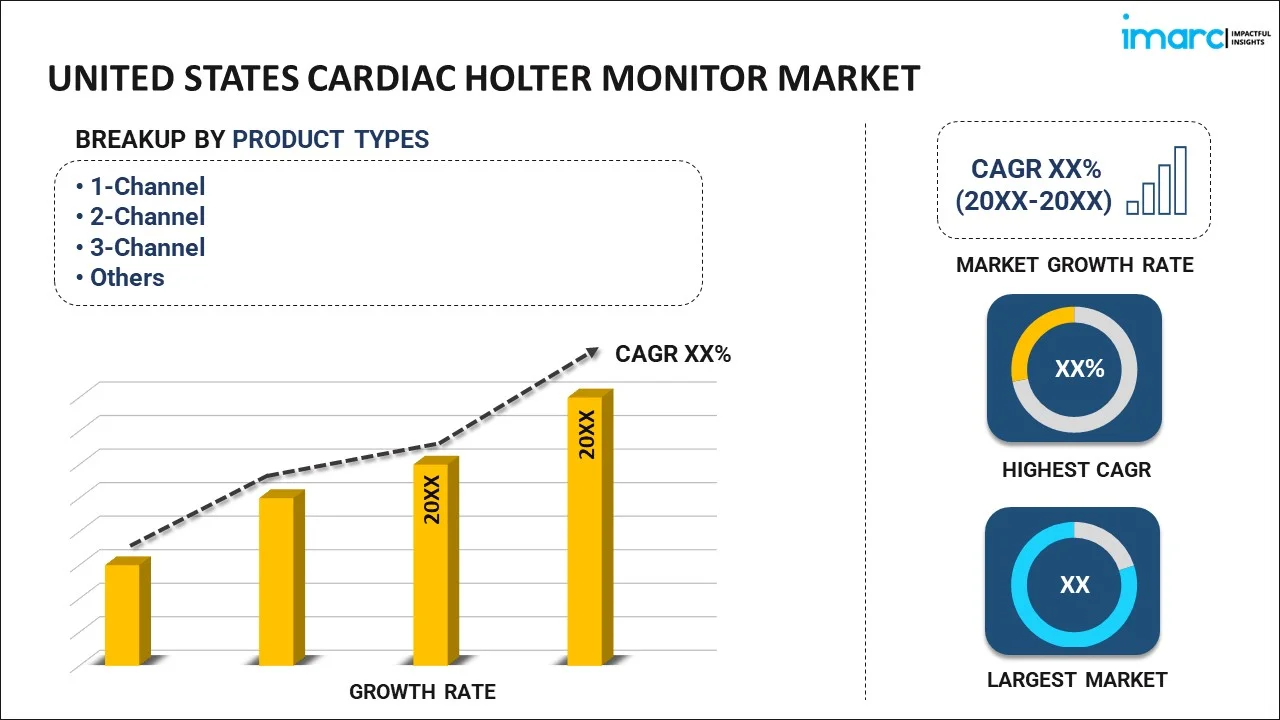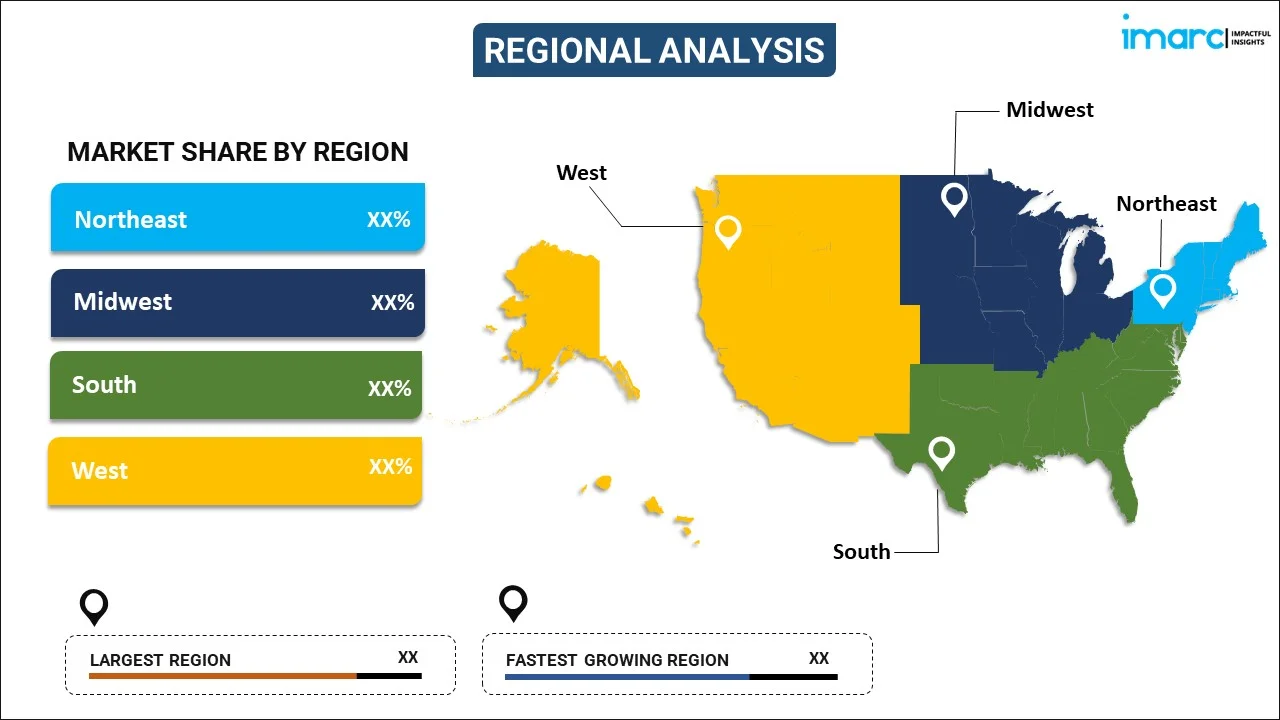
United States Cardiac Holter Monitor Market Report by Product Type (1-Channel, 2-Channel, 3-Channel, 12-Channel, and Others), Component (Holter Monitoring Devices, Event Monitoring Devices, Holter Analysis System and Software), End User (Hospitals and Clinics, Ambulatory Surgical Centers (ASCs), Homecare, and Others), and Region 2025-2033
Market Overview:
The United States cardiac holter monitor market size reached USD 164.6 Million in 2024. Looking forward, IMARC Group expects the market to reach USD 229.1 Million by 2033, exhibiting a growth rate (CAGR) of 3.70% during 2025-2033. The market is driven by heightening need for continuous cardiac monitoring, mounting cardiovascular risk factors, and the transition towards home and ambulatory care. Emerging technology in the form of AI integration, wireless connections, and enhanced data analytics is improving device precision and convenience. Such innovation is being embraced by healthcare providers to enable early diagnosis and long-term patient management. These factors combined result in the increased competitiveness and United States cardiac Holter monitor market share in the healthcare diagnostics industry.
|
Report Attribute
|
Key Statistics
|
|---|---|
|
Base Year
|
2024
|
|
Forecast Years
|
2025-2033
|
|
Historical Years
|
2019-2024
|
|
Market Size in 2024
|
USD 164.6 Million |
|
Market Forecast in 2033
|
USD 229.1 Million |
| Market Growth Rate 2025-2033 | 3.70% |
United States Cardiac Holter Monitor Market Analysis:
- Key Market Drivers: The United States cardiac Holter monitor market is fueled by growth in cardiovascular disease (CVD) cases, rising demand for early diagnosis, growing utilization in homecare, and developments in non-invasive monitoring technologies improving real-time collection of cardiac data and patient outcomes.
- Key Market Trends: New trends involve the use of AI-enabled Holter monitors, wireless and wearable device advancements, and increasing interoperability with telehealth platforms, enabling continuous, home-based, and remote cardiac monitoring in both clinical and home care environments.
- Competitive Landscape: As per the United States cardiac Holter monitor market analysis, the market is dominated by several international and local players with a focus on product innovation, miniaturization, and cloud-based data analysis to derive competitive benefits in hospitals, ambulatory settings, and remote care environments.
- Challenges and Opportunities: Challenges are restricted reimbursement for outpatient monitoring and complexity in data management, whereas opportunities are increased geriatric care, remote diagnostics, and increased application of portable devices for chronic cardiac disease care.
A cardiac holter monitor refers to a portable, battery-operated electrocardiography (ECG) device used to record the heart rate of patients over a period of 24 to 48 hours. It is a non-invasive instrument that consists of a monitor, electrodes and software for storing and analyzing the recorded data. In the United States, cardiac holter monitors are widely used in hospitals, clinics, ambulatory surgical centers and at homes to diagnosis the functioning and irregularities in the heart rate, like atrial fibrillation, tachycardia, and arrhythmia.
The United States cardiac holter monitor market is primarily driven by the increasing geriatric population and rising incidences of heart diseases. This can be attributed to rapid urbanization, hectic work schedules, sedentary lifestyles, and an increase in fast food consumption. Furthermore, the increasing expenditure on healthcare facilities is also propelling the growth of the market. Moreover, technological advancements have prompted several leading companies to launch innovative and miniaturized invasive diagnostic devices. For instance, the US-based company, iRhythm Technologies, has invented the Zio Patch that includes a holter monitor in a small pedometer-sized device with an adhesive backing.
United States Cardiac Holter Monitor Market Trends:
Trend Toward Wireless and Wearable Monitoring Solutions
The technology development trend for cardiac monitoring technologies in the United States is characterized by an increasing trend toward wireless and wearable Holter monitors. These systems provide greater convenience, allowing the patient to move freely with day-to-day activity while being continuously monitored. Greater comfort, lack of wired attachments, and a nonobtrusive design enhance patient compliance in extended monitoring. These systems are especially well-suited to the outpatient environment, minimizing the necessity of protracted hospitalization. As telehealth platforms expand and digital health technology is increasingly integrated into care delivery, wireless Holter monitors are gaining broader acceptance. The capability to provide real-time data to clinicians also enables timely intervention while aiding in improved overall disease management. This shift toward mobile, patient-centric monitoring tools is transforming diagnostic practice, signaling a significant factor in United States cardiac holter monitor market trends and reshaping how clinicians monitor cardiovascular health outside of traditional clinical settings.
AI and Remote Access in Cardiac Monitoring
Artificial intelligence and remote monitoring technology are increasingly becoming crucial in propelling the functionality of cardiac Holter monitors. With automated interpretation capabilities, physicians can effectively screen large amounts of stored cardiac signals, enhancing diagnostic precision and response time. AI-based platforms also allow predictive notifications and personalized reports, aiding in early detection of abnormalities. Together with remote access to monitoring data, these improvements offer more flexibility in the care of patients, especially those with chronic diseases. This integration simplifies workflows within clinics and facilitates increased access to monitoring in rural or underserved communities. In addition, their interoperability with electronic health records enables better coordination among healthcare providers. This technological improvement is not merely enhancing efficiency but also promoting increased adoption in preventive and routine care. All these developments are playing a major role in United States cardiac Holter monitor market expansion, particularly as the approach to healthcare moves toward more proactive and interconnected models.
Raised Demand with the Increase of Cardiovascular Risk Factors
Increased understanding of cardiovascular well-being, combined with rising incidence of the associated conditions, is fueling persistent demand for Holter monitoring within the United States. Patients at risk for arrhythmias, palpitations, and other paroxysmal cardiac symptoms are regularly referred for prolonged ECG monitoring to aid in timely diagnosis. Holter monitors enable doctors to identify abnormalities that do not manifest during routine testing and are therefore an essential tool in acute and chronic cardiac treatment. The aging population, together with lifestyle changes leading to heart disease, further increases the demand for effective and convenient monitoring technology. Therefore, cardiac Holter monitors are now an established standard care environment in various care settings, including cardiology clinics, hospitals, and home care. The focus on early identification and preventive cardiology guarantees these devices continue to be an integral component of care protocols. This shift is having a direct impact on the United States cardiac holter monitor market size, fueling innovation and clinical use along the healthcare continuum.
Key Market Segmentation:
IMARC Group provides an analysis of the key trends in each sub-segment of the United States cardiac holter monitor market report, along with forecasts at the country and regional level from 2025-2033. Our report has categorized the market based on product type, component and end user.
Breakup by Product Type:

To get more information on this market, Request Sample
- 1-Channel
- 2-Channel
- 3-Channel
- 12-Channel
- Others
Breakup by Component:
- Holter Monitoring Devices
- Event Monitoring Devices
- Holter Analysis System and Software
Breakup by End User:
- Hospitals and Clinics
- Ambulatory Surgical Centers (ASCs)
- Homecare
- Others
Breakup by Region:

- Northeast
- Midwest
- South
- West
Competitive Landscape:
The competitive landscape of the industry has also been examined along with the profiles of the key players.
Latest News and Developments:
- In April 2025, LifeSignals released the UbiqVue Holter System during Heart Rhythm 2025 in San Diego with UltraLinQ. The system includes a disposable, 2-channel wearable biosensor, a patient-facing app, and cloud-based analytics, secure ECG data transmission, and fast diagnostic reporting without needing device recovery or manual processing.
- In March 2025, Peerbridge Health launched its Cor MDx device at the HIMSS Global Health Conference in Las Vegas. The AI-powered, multi-lead ECG wearable offers 14-day Holter monitoring, mobile cardiac telemetry, and hemodynamic evaluation, with a planned commercial launch in the second half of 2025 subject to regulatory approval.
- In May 2024, Vivalink rolled out an end-to-end ambulatory cardiac monitoring solution in the United States integrating Holter and Mobile Cardiac Telemetry (MCT) features. The solution includes a reusable ECG patch, mobile gateway, and sophisticated arrhythmia detection, designed to boost diagnostic quality and efficiency in remote cardiac patient monitoring.
Report Coverage:
| Report Features | Details |
|---|---|
| Base Year of the Analysis | 2024 |
| Historical Period | 2019-2024 |
| Forecast Period | 2025-2033 |
| Units | Million USD |
| Segment Coverage | Product Type, Component, End User, Region |
| Region Covered | Northeast, Midwest, South, West |
| Customization Scope | 10% Free Customization |
| Post-Sale Analyst Support | 10-12 Weeks |
| Delivery Format | PDF and Excel through Email (We can also provide the editable version of the report in PPT/Word format on special request) |
Key Questions Answered in This Report
The cardiac holter monitor market in the United States was valued at USD 164.6 Million in 2024.
The United States cardiac holter monitor market is projected to exhibit a (CAGR) of 3.70% during 2025-2033, reaching a value of USD 229.1 Million by 2033.
Drivers of the United States cardiac holter monitor market include rising incidence of cardiovascular conditions, expanding geriatric population, and escalating need for timely and precise cardiac diagnosis. Improvements in technology such as wireless monitoring, AI-based data analysis, and connectivity with telehealth platforms further increase diagnostic effectiveness, thereby boosting adoption among hospitals, clinics, and home healthcare centers.
Need more help?
- Speak to our experienced analysts for insights on the current market scenarios.
- Include additional segments and countries to customize the report as per your requirement.
- Gain an unparalleled competitive advantage in your domain by understanding how to utilize the report and positively impacting your operations and revenue.
- For further assistance, please connect with our analysts.
 Request Customization
Request Customization
 Speak to an Analyst
Speak to an Analyst
 Request Brochure
Request Brochure
 Inquire Before Buying
Inquire Before Buying




.webp)




.webp)












